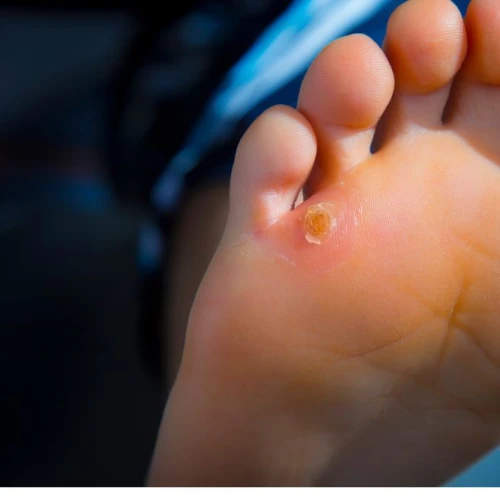Symptoms: how do you recognise a corn on your foot?1, 2
A corn is a small area of thickened skin on the feet. The area is clearly delimited and the size of a pea or slightly larger. A corn penetrates into the dermis (deeper layer of the skin). It is composed of two parts:
- A rounded, hardened and transparent core, visible under the skin of the foot;
- An inverted cone-shaped tip embedded in the dermis at the level of the bone below the corn.
A fluid-filled sac can sometimes form under the corn. The doctor or podiatrist will treat the corn by trimming the thickened part of the skin. After a corn has been trimmed it will look like a round lesion with a well-defined translucent yellow centre that breaks up the normal appearance of the papillary dermis (a thin layer located on the surface of the epidermis).
There are two types of corn2:
Hard corns
Hard corns are more far common and appear in areas directly exposed to rubbing and pressure from wearing shoes. They can develop:
- On the tops of the toes (especially the last three), and more specifically in the joints between the toe phalanges;
- On the outside of the little toe, an area of skin that tends to rub against footwear.
Hard corns are sensitive and can even be painful when touched. They can hinder the way someone walks by forcing the person to change the way they position their foot down to prevent the pain caused by the rubbing. In the elderly, the presence of hard corns increases the risk of falls.
Soft corns
Soft corns develop between two toes, most commonly between the fourth and fifth toes. They often appear in pairs, i.e. two corns on two different toes will be facing each other. Soft corns appear when two joints of two neighbouring toes are pressed against each other. They are sometimes called “partridge eyes” because they are round in shape with a red border (inflamed area) and a black dot in the centre. Soft corns are white coloured and have a spongy appearance due to the sweat secreted between the toes.
Just like hard corns, soft corns are painful. There is also a risk of infection due to maceration in the gaps between the toes. In the most serious cases, an infected corn can spread to the envelope of the nearby joint.
What causes a corn on the foot?1, 2
In most cases, corns are caused by poorly fitting footwear. They form as a result of repeated rubbing of the feet against shoes or excessive compression of the skin against a bony prominence on the foot when walking. This repeated rubbing and compression leads to hyperkeratosis as they stimulate the production of keratin (a protein found in the skin). This natural mechanism causes a thickening of the corn on the foot.
Smaller sized corns (the size of a seed), located in non-weight bearing areas of the feet, can indicate a rare condition called hereditary genodermatosis.
Who is at risk? 2
Corns, hardened skin and calluses are more common in:
- Women as wearing narrow, high-heeled shoes causes rubbing and compression of the forefoot.
- Athletes as greater exertion is required from their feet (long walks, running, etc.).
- People with large toes or thin skin, as both these features expose the skin to rubbing when wearing shoes and make them more sensitive to pressure.
- Elderly people as the skin on their feet is drier, thinner and more sensitive to compression and irritation.
- Patients with deformed feet or toes. For example, corns, hardened skin and calluses are more common in people with hallux valgus (“bunion”), hammer toes, claw toes, and flat or hollow feet.
Deformed feet or toes therefore change the statics, i.e. the way the feet position themselves to support the body’s weight. This generates extra pressure on some areas of the skin and causes the shoes to rub.
How do you get rid of a corn on the foot?3
You can treat a corn on your foot at home by following a few simple steps.
Remove excess skin with a pumice
Use a pumice stone, file or emery paper to gently remove the thickened skin. This will gradually remove the excess layer of skin. The best way to remove excess skin is to soften the area by soaking your feet in warm water for 20 minutes and regularly apply moisturising cream.
Use corn-removal products
Use corn-removal products to remove the centre of the corn. These products contain salicylic acid which dissolves keratin, softens the stratum corneum and makes it drop off. These products are available in the form of ointments, pastes or plasters. Only apply the product to the area of the corn, as it can also destroy healthy skin, causing an injury. After applying the corn-removal product, cover the treated area with a protective dressing.
These over-the-counter products are available from chemists and can be used by most people. However, diabetics, people with peripheral arterial disease affecting the lower limbs or people suffering from a skin condition affecting their feet (eczema, psoriasis, etc.) should not use them.
If you are diabetic and have a corn on your foot, don't try to treat it yourself at home, make an appointment with a pedicurist/podiatrist. People with diabetes have an increased risk of injury or infection caused by irritation after using a pumice stone on the skin, but there is also an increased risk of poor healing after using a corn-removal product.
Wear suitable footwear
If you have a corn on your foot, wear light and soft shoes that are wide enough to prevent repeated rubbing. When you put them on, make sure there’s room enough for your feet and the top of your toes. Choose shoes with a good sole and low heel (3-4 cm).
Take care of your feet
if you have one or more soft corns, wash your feet every day with soap and water and dry them well afterwards. Do not forget about the gaps between your toes. Remember, maceration (presence of moisture and heat in an enclosed space) encourages infection in soft corns due to bacteria or fungal infections.
If you have one or more hard corns, apply moisturising cream every day to limit dry skin.
When should you seek medical advice?3
Corns are benign lesions and in most cases they disappear with home care. However, it is best to consult a doctor or pedicurist/podiatrist if:
- The corn becomes infected (red and very painful);
- The discomfort is so intense it stops you doing some of your usual activities;
- You have fallen due to the corn on your foot;
- You are diabetic or have peripheral arterial disease affecting your lower limbs;
- You have a skin condition affecting your feet.
Does a podiatrist treat corns?4
If necessary, a doctor can prescribe pedicurist/podiatrist care to remove the corn/s. A pedicurist/podiatrist will remove the corn with a sharp and/or rotary instrument. This type of action gradually reduces the volume of the corn. The intervention of a pedicurist/podiatrist helps alleviate pain when walking by reducing the pressure exerted on foot tissues. It may take several sessions to completely remove the corn.
If the pedicurist/podiatrist believes the corn was caused by pressure exerted on your foot, they can recommend customised orthopaedic inserts or toe orthotics, which are customised removable orthotics that stop the toes from rubbing together.
Regular care from a pedicurist/podiatrist may be necessary in patients who are prone to painful and stubborn corns.
Role of general practitioners4
If a corn becomes infected, general practitioners can prescribe disinfectant treatment and, if necessary, nursing care delivered by a pedicurist/podiatrist.
Finally, when corns are caused by a deformity of the toes or foot, your general practitioner may recommend that you:
- Wear orthopaedic inserts;
- Wear orthopaedic shoes;
- Have orthopaedic surgery to correct a major deformity (e.g. hallux valgus surgery).


